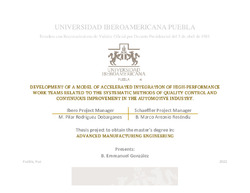Mostrar el registro sencillo del ítem
Evelopment of a model of accelerated integration of high-performance work teams related to the systematic methods of quality control and continuous improvement in the automotive industry
| dc.date.issued | 2022 | |
| dc.identifier.uri | https://hdl.handle.net/20.500.11777/5364 | |
| dc.description.abstract | Due to complaints from our customers for poor quality, we have had significant financial losses. Therefore, we use the Design Thinking methodology. • First, we define the problem: With the data collected from these claims we were able to obtain two major causes with the help of the model of systemic causes prioritization: o Training and compliance with work instructions o Capacity to monitor failures). • Later, we empathize with users through knowledge of current systems where we discover that: o the current operator efficiency system doesn’t evaluate the adequate operator attributes, which affects directly to the manufactured product. o the current problem-solving system doesn't contemplate the step by step follow up failures closely. • Upon completion, we ideated solutions to the following questions: o how can we create a solution where, through operator skills, their growth interests are highlighted, and behavior aligns with company goals? o how can we create a solution where, through an effective collaboration and a follow-up, the failures reported can be closed appropriately? • With these good ideas, we make digital prototypes as a solution to the questions: o We made the proposal design to reinforce the behaviors that we require from the operators on the production floor. o We designed a collaborative solution that included one the most complete methodology such as 8Ds And finally in the last phase of testing, we are generating a lot of data to be able to make decisions after several improvements thanks to user feedback. Roll out phase is taking place and the positive results we are expecting (reduction of customer complaints, internal complaints, near misses and Internal Audits) can be viewed at the first quarter of the next year. Depending on that results we can start thinking in a way of adding the courses to the data base to automatically assign the training the operator needs to improve its knowledge. Also, colleagues from North America are interested with the proposal applications, so whether the application can be applied in other plants or maybe IT can develop an application, not only local but regional. Due to the above, I see it as extremely important to know how to identify the real problem by knowing the true needs of the user; In this case, my job at Schaeffler is practically as a user and therefore I understood those needs very quickly. Afterwards, it is just as important to know how to ask the right question to start ideating solutions, which could take a few weeks. As a next step it is vital that if digitization is required to be added to the project there must be proper training and many hours of self-study and finally a great support team as multiple tests needed to be performed on the system. | spa |
| dc.format | spa | |
| dc.language.iso | Inglés | spa |
| dc.rights | Acceso Abierto | spa |
| dc.rights.uri | Atribución-NoComercial CC BY-NC | spa |
| dc.subject | Automóviles | spa |
| dc.subject | Control de calidad | spa |
| dc.subject | Producción | spa |
| dc.subject | Industria automotriz | spa |
| dc.subject | Design Thinking | spa |
| dc.title | Evelopment of a model of accelerated integration of high-performance work teams related to the systematic methods of quality control and continuous improvement in the automotive industry | spa |
| dc.type | Tesis | spa |
| dc.contributor.author | González, Emmanuel | |
| dc.date.accessioned | 2022-07-15T17:52:24Z | |
| dc.date.available | 2022-07-15T17:52:24Z | |
| dc.contributor.advisor | Rodríguez Dobarganes, Pilar | |
| dc.type.version | Versión aceptada | spa |
Archivos en el ítem
Este ítem aparece en la(s) siguiente(s) colección(ones)
-
Tesis [20]

